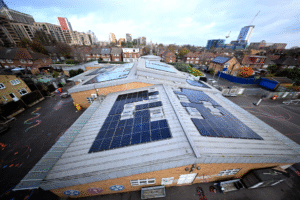The universities are partnering with the UK Centre for Ecology & Hydrology on groundbreaking energy research.
A study of around 68,000 inland bodies of water across the world gauged the potential for electricity generation from floating solar arrays. This was based on average local climate conditions.
Lakes and reservoirs were chosen based on specific criteria. They had to be within 10km of a population centre, the location needed to be unprotected and unlikely to freeze or dry out for more than six months of the year.
Arrays would also take up no more than 10% of the water surface, with a maximum area of 30km2. Based on these specifications, 1,302tW of power could be generated annually, which is equivalent to four times the UK’s total electricity demand.
Locations in Papua New Guinea, Ethiopia, and Rwanda were among those featured in the work, all of which could meet their entire power needs by switching to floating solar. Bolivia and Tonga, meanwhile, could supply 87 and 82% of their power in this way, and most countries in Africa, the Caribbean, South America and Central Asia could cover between 40 and 70% of their requirements. The UK lagged behind, and was found to be capable of producing just 1% of overall electricity – enough for 1million homes.
Floating solar arrays, or FPVs, have a number of advantages over land-based infrastructure, including water’s natural cooling effects, making individual panels more efficient. As there are no fixed structures, the technology is easy to install and relocate.
Water evaporation is also reduced, improving ecological resilience in hotter environments, and FPVs can also limit algae growth. Nevertheless, the teams acknowledged more research is needed into the impact on surrounding nature and animals.
‘We still don’t know exactly how floating panels might affect the ecosystem within a natural lake, in different conditions and locations,’ said Dr Iestyn Woolway of Bangor University, lead author of the paper. ‘But the potential gain in energy generation from FPV is clear, so we need to put that research in place so this technology can be safely adopted.
‘We chose 10% of a lake’s surface area as a likely safe level of deployment, but that might need to be reduced in some situations, or could be higher in others,’ the continued. ‘Even with the criteria we set to create a realistic scenario for deployment of FPV, there are benefits across the board, mainly in lower income countries with high levels of sunshine, but also in Northern European countries as well. The criteria we chose were based on obvious exclusions, such as lakes in protected areas, but also on what might reduce the cost and risks of deployment.’
Even with the criteria we set to create a realistic scenario for deployment of FPV, there are benefits across the board, mainly in lower income countries with high levels of sunshine, but also in Northern European countries as well. The criteria we chose were based on obvious exclusions, such as lakes in protected areas, but also on what might reduce the cost and risks of deployment.’
















